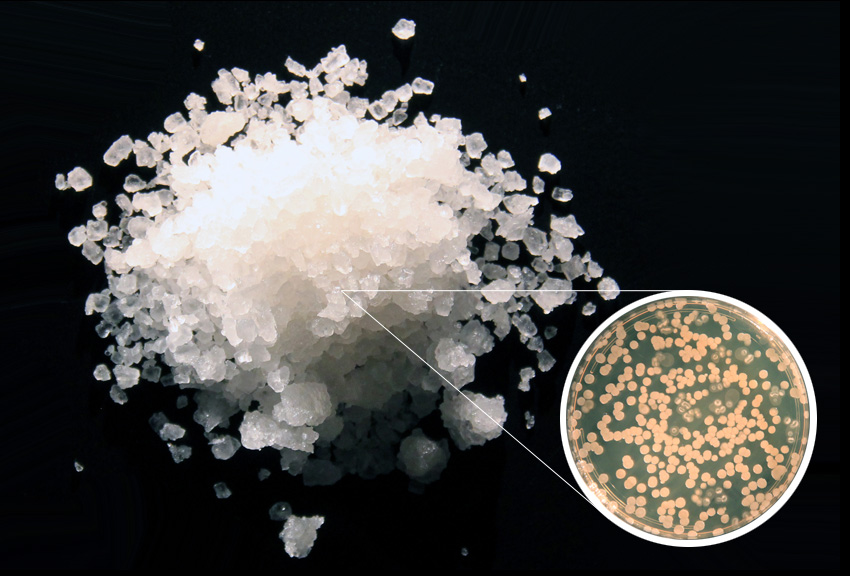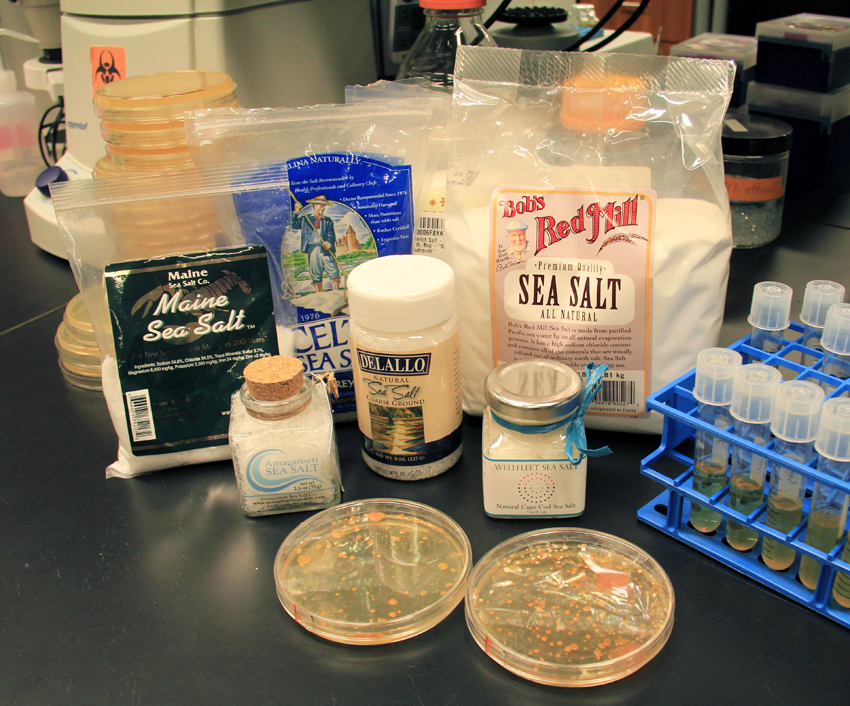Chefology: There Might Be Bacteria in Your Artisan Sea Salt
Welcome to Chefology, where married couple Ben Wolfe (a Harvard microbiologist) and Scott Jones (the chef de cuisine at No. 9 Park) explore the relationship between biology and haute cuisine. This is, quite literally, a marriage of science and cooking.

Photos by Ben Wolfe
It’s a rare moment in science when a very simple observation completely changes your view of the world. But Ben recently stumbled on something that has completely changed the way we think of a key ingredient in the kitchen: salt.
We normally think of salt as doing two things in the kitchen. The most important use of salt is to bring out the flavors in food. Whether it’s salt used during the cooking process to bring out flavors of ingredients as they cook or large granular salt added to finish a plate to get the mouth watering, salt is a staple in the preparation of almost any dish.
The other major use of salt is as a tool for food preservation. In the process of food fermentation, salt is used as a way to control the growth of good versus bad microbes. During the process of meat curing, high salt concentrations are used to prevent the growth of microbes. In the world of food preservation, we think of salt as a microbe killer and a food saver.
But it turns out that some salts aren’t just microbe killers. In fact, some sea salts are packed full of microbes that could possibly grow on your food.
In the course of Ben’s research at Harvard on cheese microbiology, he noticed that scientists in Europe and California found bacteria on the surfaces of naturally aged cheeses that were normally only found in the ocean. With his colleagues in the Dutton Lab at Harvard, he’s isolated similar microbes from many cheeses from around the world. That made him begin to wonder how these ocean microbes made it onto the cheese.
One obvious source of the ocean microbes is the sea salt that cheesemakers use during the production of artisan cheeses. Cheesemakers use sea salt to add flavor to cheese as well as control the growth of microbes on the cheese rinds. If there were microbes living in the sea salt that cheesemakers used, they could end up in the cheeses. Ben began to wonder if the same ocean microbes could be in artisan sea salts that are made and sold around the world.

Sampling artisan salts for bacteria. (Photo by Ben Wolfe)
To determine if there are live bacteria in sea salt, Ben bought seven different types of minimally processed sea salts and took them to the lab for testing. The salts included French Grey Sea Salt, Celtic Sea Salt, Bob’s Red Mill Sea Salt, DeLallo Sea Salt, Maine Sea Salt, Amagansett Sea Salt, and Wellfleet Sea Salt. He used basic microbiology techniques to plate out the samples onto Petri dishes with ideal microbe food. If there were bacteria present, they would grow on the plates and form small circular growths called colonies.
Much to Ben’s surprise, he found that some sea salts are packed full of bacteria. Four of the seven salts had detectable bacteria. The bacteria were generally quite low in abundance, but one sample had about 4,000 bacterial cells in a teaspoon of salt! The salts that were very minimally processed—damp, with larger crystals and light grey in color—had the highest number of bacteria. The more refined salts that were pure white had no detectable microbes. Each salt had its own mix of bacteria as can be seen in the photo panel below:

Photos by Ben Wolfe
Above, bacteria isolated from four different artisan salts. Four different salts (top row) had detectable levels of bacteria in them. Petri dishes (bottom row) show bacteria isolated from each of the sea salts. From left: Celtic Sea Salt, Amagansett Sea Salt, Wellfleet Sea Salt, and French Grey Sea Salt.
Who are these critters living in your artisan salt and should this be cause for alarm? Most of these bacteria are Proteobacteria, a group of bacteria that are commonly found in the oceans. All of these sea salt bacteria Ben isolated are halophilic, meaning they love and can tolerate high concentrations of salt. There are some pretty nasty bugs in this category of bacteria (including the bacterium that causes cholera), but it’s unlikely that these pathogens would survive in this harsh salt environment. And because the bacteria were generally quite low in abundance, you’d have to use a lot of salt to get enough of these into your body’s digestive tract to cause any harm.
The fact that these minimally processed sea salts contain viable microbes may not be that surprising. To make these artisan sea salts, salt producers collect ocean water and evaporate the water in the sun to create salt crystals. Any organisms that can tolerate the heat and the high concentration of salt can persist as a dormant cell, just like plant seeds can happily sit around for months or years. When the conditions are right, these dormant bacteria wake up and grow. In Ben’s case, it was on Petri dishes in the lab. But it’s also possible that these bacteria could wake up and grow in your food.
The potential role of these sea salt microbes in the production of fermented foods remains an open question. In addition to the presence of these microbes in cheese mentioned above, scientists in Korea recently found that sea salt microbes make awesome batches of kimchi. And when I mentioned the existence of these salt bacteria to fermentation guru Sandor Katz, he was surprised and excited about the possible role of ocean microbes in vegetable fermentations. Could salt microbes from Cape Cod be putting the funk in your sauerkraut? Ben’s working on that—stay tuned for more.

